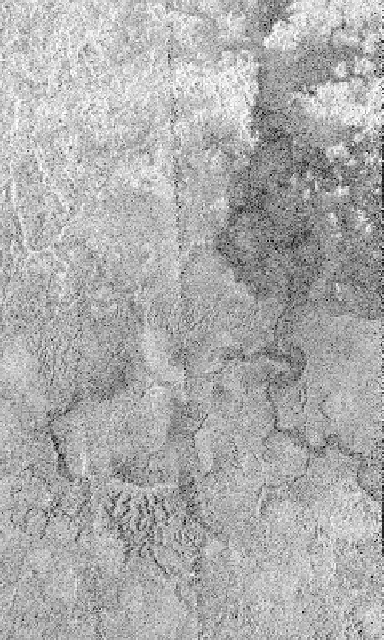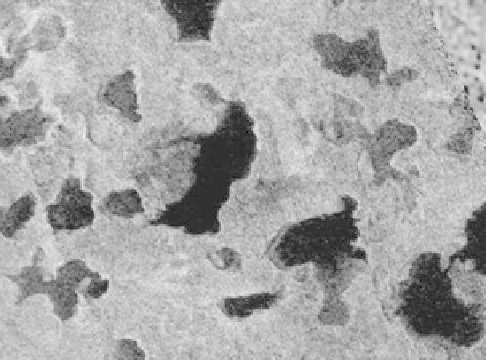Geology Reference
In-Depth Information
Figure 9.13. A radar image showing bodies of liquid methane
-
ethane in Titan
s north polar area. Such lakes and larger seas are
abundant and are concentrated in the higher latitudes, especially in
the north polar region; repeat radar imaging shows that some lakes
disappear with Titan
'
'
s seasons (NASA Cassini PIA09183).
ocean and sink. While global oceans were not found, Titan
has abundant lakes (
Fig. 9.13
), many of which are
“
fed
”
by channels and show distinctive shorelines. These fea-
tures are radar-dark, indicating smooth surfaces, while the
multispectral data show hydrocarbon compositions of a
methane
-
ethane mixture. More than 1,000 such lakes
have been found, ranging in size from a few kilometers
across to the feature named Kraken Mare that is more than
400,000 km
2
in extent. All of the lakes occur in polar
regions, which is consistent with their methane
Figure 9.12. Cassini radar images of Titan
s south polar area,
showing complex, chaotic terrain degraded by a variety of processes,
including
'
fluvial erosion that formed the sinuous valley and channel
system. The vertical black line is the seam between two images
(NASA PIA10219).
ethane
compositions that require lower temperatures in order
for them to be liquid. However, there are some 20 times
more lakes seen in the north than in the south. This might
be explained by Titan
-
presence of liquid methane or smooth ice. Many of the
channels and valleys form
“
ordered
”
systems of tributar-
ies, similar to
fluvial systems on Earth, suggesting runoff
from precipitation, although some could emerge from
underground sources. Some models of the rate of possible
rainfall on Titan suggest that
“
ash-
oods
”
could occur,
while other models are much more conservative and sug-
gest that precipitation is substantially less and would be
comparable to desert conditions on Earth. One possibility
is that high-volume precipitation occurs rarely, leading to
occasional
ash-
oods that recharge subsurface reser-
voirs, as is typical of a dry climate.
Terrain such as that shown in
Fig. 9.12
of the south
polar region has been extensively modi
ed by
fluvial
processes, which are evidenced by small narrow valleys,
large meandering channel systems, and chaotic terrain.
Some early considerations of Titan
s seasons that result from its orbital
inclination and its 30-year journey around Saturn each
Titan year. Because the orbit of Saturn itself around the
Sun is not circular, even longer-term cycles of heating and
cooling are possible. Lakes have been monitored through
repeat imaging and some in the south polar region dis-
appeared toward the end of the Titan southern hemisphere
summer, as a consequence of evaporation.
Aeolian processes constitute the other primary means of
surface gradation. As shown in
Fig. 3.36
, wind tunnel
experiments and theoretical considerations suggested
that aeolian processes could occur on Titan (Greeley and
Iversen,
1985
). The extensive dunes were one of the most
interesting Cassini discoveries. The dunes shown in
Fig. 9.14
are typical of a band that covers 40% of the
surface between 30° north and south of the equator.
'
s surface included
vast oceans of liquid hydrocarbons; in fact, there was
concern that the Huygens probe might land in such an
'




